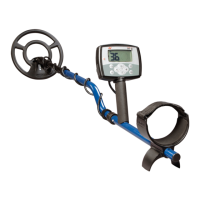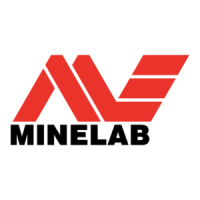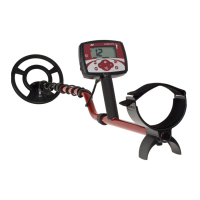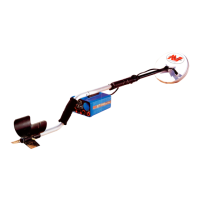detector audioa simple detecting exercise
Target Response
(Metal Object Response)
This is the sound given by the detector when
a target is located and not discriminated
(rejected).
In Coin & Treasure Mode a highly conductive
target (e.g. a large silver coin) will generally
cause a high pitched beep and a ferrous target
will generally cause a low pitched beep.
In Prospecting Mode, a target will cause an
abrupt change in pitch and volume of the
Threshold tone. Detections are indicated by
sound only.
(Tones, p. 38)
(Sounds, p. 50)
False Signals
The detector may also produce False Signals
(Noise) when not over the ground or with the
coil held motionless. These may not be target
signals, but surrounding electromagnetic
interference (EMI). The Ground Balance and
Noise Cancel settings can be used to overcome
these false signals.
(Noise Cancel, p. 32)
(Ground Balance, p. 40)
Highly mineralised
soil may produce false
signals and distract
from real targets.
Don’t worry if the detector is not producing
a sound over the nail — this is because the
detector begins in the default Pattern 1, a
setting which rejects signals from common
junk targets, including ferrous targets.
Note: If you are getting signals from a clear patch
of ground, there could be buried metal objects.
Try nding another area.
If the detector is making popping and crackling
sounds, and displaying numbers when the
coil is not over one of the metal objects, try
reducing its Sensitivity (p. 30). Once stable, the
detector will sound and display numbers only
when the coil is passed over a target.
Buried metal objects are referred to as targets.
Before attempting to pinpoint or recover real
targets, it is important to understand how to
interpret the audio and visual signals of
the detector.
A good way to become familiar with detecting
is to test the detector with a range of metal
objects. This exercise is a simple lesson on how
the detector interprets metal objects.
Gather a collection of dierent metal objects,
e.g. various coins, gold and silver jewellery, a
nail, pull-tab, brass button and aluminium foil.
Take the detector outdoors, away from known
electromagnetic elds or metal objects.
Lay objects in a line, suciently spaced apart
to allow the coil to pass between the objects.
Pass the coil across the objects one at a time,
and observe the LCD and the sounds of the
detector as it detects each object.
This test exercise may be used when
adjusting the settings of the detector
(Sensitivity, p. 30; Threshold, p. 34;
Volume, p. 36; Tones, p. 38).
‘Blanking’ (No Sound)
Threshold
Threshold
Normal Signal
Threshold (Background sound)
This is the background ‘buzz’ produced by the
detector, used to help distinguish between
desired and undesired objects.
Blanking
When a rejected target is detected the
Threshold sound ‘blanks’ (becomes silent),
indicating that a target is located underneath
the coil but has been rejected by your
discrimination pattern. Blanking is a useful
way of distinguishing between desired and
undesired targets.
Nail Pull-Tab Foil Coins Jewellery
